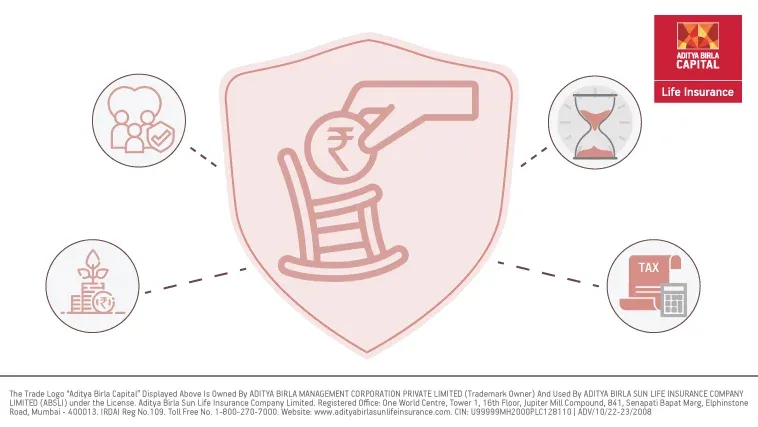Aditya Birla Sun Life Insurance Company Limited
Let's Invest in Retirement Plan This Diwali| ABSLI

Plan Smarter, Live Better!

Thank you for your details. We will reach out to you shortly.

Currently we are facing some issue. Please try after sometime.


- Table of Contents
Its a new year and we already have our bucket list full with our to-do things. Traveling to a dream destination, getting admission in a desired university, lose weight, marry, have a baby, and our bucket list can go on and on. Besides all the other things, it can also be the right time to start your retirement planning.
1) The ‘What’
Retirement planning means creating a financial corpus for your retirement. It means the creation of a regular source of income in your older years when you retire from active employment or business.
2) Why to Invest in Retirement Plan?
Retirement planning is essential to ensure financial independence after retirement. When you have a corpus at your disposal, you can meet your lifestyle expenses and medical needs even when you have no active source of income. You don’t have to depend on anyone else once your income stops, as your retirement corpus provides you with the financial security that you need.
Moreover, when creating a retirement corpus, the sooner you start, the better. The reason is simple. When you have time on your side, you can save small amounts regularly and build up a suitable corpus with the help of compounding returns.
Compounding helps you grow your corpus exponentially. However, it needs time to work its miracle. You can give compounding this time by starting as early as possible. Here’s an example of putting things in perspective –
Say you invest ₹5000 monthly into an investment avenue that generates 12% annual returns. In the first case, you start investing at 35 years of age, while in the second instance, you delay by 10 years and start at 45.
If your retirement age is 65 years, the corpus created in the first instance would be around ₹1.75 crores2 by investing a total of ₹18 lakhs, while in the latter case, it would be around ₹49.46 lakhs by investing ₹12 lakhs. A delay of 10 years and your corpus is reduced more than thrice whereas the investment corpus is only ₹6 lakhs less!
This is the power of compounding that can help you create wealth but only if you give it time. Even now is not too late. You can start your retirement planning this New Year itself. Better late than never!
3) How to Create Retirement Corpus?
Now that you know what retirement planning is and why it is needed let’s understand how to create a retirement corpus.
Here’s where you have to take steps to save and invest your savings into suitable avenues that can help you create an adequate retirement corpus.
Here’s how you can go about the process –
a) Estimate the Retirement Corpus That You Would Need
The first step in retirement planning is estimating the corpus you need after retirement. To do so, factor in your lifestyle costs and the average annual inflation rate. Then, calculate the inflated costs at the time of retirement to get an idea.
For example, say your monthly expenses amount to ₹25,000 presently. You intend to retire after 30 years. If the expected inflation rate is about 6%, your monthly expenses on retirement will amount to ₹1.43 lakhs (approximately). This amounts to an annual expense of ₹17.16 lakhs. If you retire at 65 years and consider your life expectancy till 100 years, you need a corpus of ₹6 crores (approximately).
You can do the calculation yourself, or you can use the retirement calculator available online. These calculators make the job of estimating the corpus easier as you just enter in your details, and you get the ideal corpus that you need to create.
b) Set Aside a Part of Your Income Every Month Towards the Estimated Corpus
Once you find out the estimated corpus, the next thing to do is start saving towards it. The ideal way of doing so is to set aside a part of your monthly income. Monthly savings allow you to save small and affordable amounts that can accumulate into an optimal corpus, thanks to the power of compounding.
For instance, in the aforementioned example, a corpus of ₹6 crores is needed. If you have 30 years to save and the investment avenue that you have chosen delivers 12% returns per annum, you need to save ₹17,200 every month so that you can create a corpus of ₹6 crores.
i) Assess Your Risk Appetite and Investment Horizon
After you calculate the monthly savings required, you need to invest the savings into suitable avenues. Investments generate returns that help you create the desired corpus.
When choosing the investment avenues, you need to keep two things in mind – your risk appetite and your investment horizon.
Risk appetite is your capacity to tolerate investment risks. Based on this appetite, you can choose the investment avenue. For instance, if you don’t mind the volatility risks associated with equity, you can invest in equity for attractive returns. On the other hand, if you are risk-averse or can handle only a limited amount of risk, debt or a mix of equity and debt would be suitable investment avenues.
Besides risk appetite, check your investment horizon. This is because some avenues have a long-term horizon while others are available for a shorter tenure too. For instance, choosing the National Pension System would have a long-term tenure maturing at 60 or 70 years of age. On the other hand, life insurance pension plans allow tenures starting from 5 years onwards. Moreover, the investment horizon determines the savings needed every month to create the desired corpus.
So, estimate your retirement age so that you can save accordingly.
ii) Plan Your Taxes3
The Income Tax Act of 1961 allows various tax-saving investment avenues to help you create a tax-efficient retirement corpus. Depending on your risk appetite, investment horizon, and the returns offered by the different investment avenues, pick the most suitable ones that also help save taxes.
Some tax-saving avenues that you can choose from are as follows –
A. Life Insurance Deferred Pension Plans
Deferred pension plans offered by life insurers are retirement-oriented insurance policies. Under these policies, you can save up and create a retirement corpus. Insurance coverage is allowed during the policy tenure, while on maturity, you can get regular incomes in the form of guaranteed# annuity payments.
Deferred pension plans are allowed as unit-linked policies if you want to invest in the capital markets. Alternatively, you can choose traditional plans for guaranteed# returns.
The premium that you pay for the policy is allowed as a deduction from your taxable income. You can enjoy a deduction of up to Rs.1.5 lakhs under Section 80CCC4 and bring down your tax liability. While the death benefit is completely tax-free, you get a tax benefit* on maturity too. If you commute a part of the corpus, you enjoy tax exemption on the commuted corpus (up to 1/3rd of the corpus) under Section 10(10A).
B. National Pension System (NPS)
Another retirement-oriented scheme, the NPS scheme, allows you to save till retirement and then get lifelong annuities. The savings are invested in the capital market through the different types of funds so that you can get inflation-adjusted returns.
Investments are allowed as a deduction under Section 80CCD(1)5. The limit is Rs.1.5 lakhs which includes the limit under Section 80C and 80CCC. However, the NPS scheme allows an additional deduction of up to Rs.50,000 under Section 80CCD (1B). This additional deduction makes the scheme tax-efficient.
On maturity, you can withdraw up to 60% of the accumulated corpus, which is also tax-free in your hands. The remaining corpus, however, would be used for annuity payments, and such payments would be taxed in your hands at your slab rates.
C. Public Provident Fund
The PPF scheme is a fixed-income saving scheme with a maturity of 15 years, extendable by 5 years after that. You get guaranteed# interest income on your savings, and can save with as little as ₹100.
The investment into the PPF scheme is allowed as a deduction under Section 80C up to Rs.1.5 lakhs. Moreover, the returns earned and the maturity proceeds are also tax-free.
D. ELSS Schemes of Mutual Funds
Equity Linked Saving Schemes offered by mutual funds are also tax-saving investment avenues. ELSS schemes invest in equity and, thus, have a high-risk profile but also a high-return potential. There’s a lock-in period of 3 years during which withdrawals are not allowed.
Saving into the ELSS scheme is eligible for a deduction under Section 80C up to Rs.1.5 lakhs. Returns up to Rs.1 lakh are tax-free. However, if the returns are higher, you incur a 10% taxation on the excess returns.
Ideally you should invest Rs. 1,50,5006 in ELSS to get a benefit of Rs. 1.5 lakhs because 0.005% is deducted as stamp duty before investing.
E. 5-year Fixed Deposit Schemes
5-year fixed deposit schemes offered by banks and post offices save tax under Section 80C. investment, up to Rs.1.5 lakhs, qualifies as a deduction from your taxable income. Interest income, however, is taxable if you are below 60. For senior citizens, interest income up to Rs.50,000 is also tax-free under Section 80TTB7.
Fixed deposits give a guaranteed# rate of interest on your deposit, and the investment duration is five years.
F. National Savings Certificates
National Savings Certificates are also fixed-income saving schemes like PPF and 5-year fixed deposits. The investment tenure is five years, and you get a guaranteed# interest rate during the tenure. The minimum required investment is Rs.1000, while there is no maximum limit. Investments up to Rs.1.5 lakhs8 qualify as a deduction under Section 80C.
iii) Pick Suitable Avenues
You can choose one or more of the aforementioned investment avenues that align with your financial goals, risk appetite, and investment strategy. Start investing so that your retirement corpus starts growing with returns.
The Bottom Line
Let this New Year be an important milestone in your life. Give a shubharambh to retirement planning this New Year, and start saving up for your golden years. Make your retirement financially secure so that you can indulge your whims and desires and fulfil your bucket list without any worries. Make your old age golden by carefully mapping out a retirement plan starting this year.
Thank you for your details. We will reach out to you shortly.
Thanks for reaching out. Currently we are facing some issue.
Give ₹1 lakh/ month for 5 years and Get ₹ 4.06 lakhs every year till your life1
ABSLI Guaranteed Annuity Plus
Multiple annuity options, Regular income stream.
Guaranteed# lifelong income
Top-up option for annuity
Single/Joint Life cover option
Deferred annuity option
Give :
₹ 1 lakhs/Month for 5 year¹
Get :
₹4.06 lakhs/-
Most Popular Calculator
Guaranteed returns after a month¹
2 https://www.mutualfundssahihai.com/en/calculators
3https://incometaxindia.gov.in/tutorials/20.%20tax%20benefits%20due%20to%20health%20insurance.pdf
4 https://cleartax.in/s/section-80ccc
5 https://cleartax.in/s/section-80ccd
6 https://economictimes.indiatimes.com/wealth/tax/invest-more-than-rs-1-5-lakh-in-elss-mutual-fund-to-claim-full-benefit-under-section-80c-experts/articleshow/82901058.cms
7 https://cleartax.in/s/section-80ttb
8 https://cleartax.in/s/nsc-national-savings-certificate
* Tax benefits are subject to changes in tax laws. Kindly consult your financial advisor for more details.
ADV/10/22-23/1967







